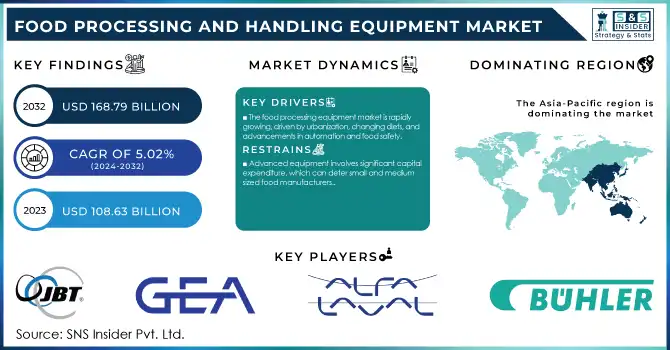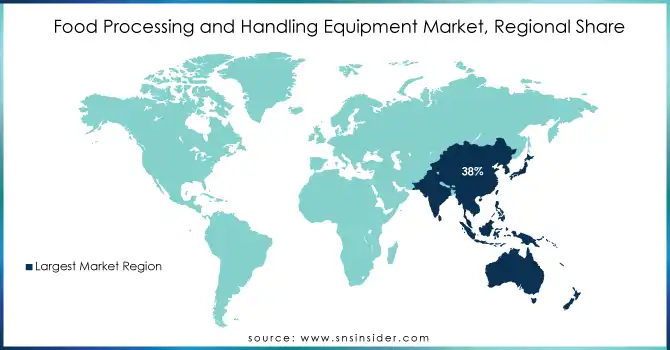Food Processing and Handling Equipment Market Key Insights:
The Food Processing and Handling Equipment Market size was estimated at USD 108.63 Billion in 2023 and is expected to reach USD 168.79 Billion by 2032 with a growing at a CAGR of 5.02% during the forecast period of 2024-2032.

To Get More Information on Food Processing and Handling Equipment Market - Request Sample Report
The food processing and handling equipment market is witnessing robust growth driven by increasing consumer demand for convenience and processed foods. Technological advancements in equipment design and automation have significantly enhanced production efficiency and food safety, catering to the stringent regulations imposed by food authorities globally. Trends such as the adoption of Industry 4.0 technologies, including IoT-enabled equipment and AI-driven process optimization, are reshaping the industry, allowing manufacturers to achieve precision, reduce waste, and improve traceability across the food supply chain. One of the key drivers is the growing emphasis on sustainability, leading to the development of energy-efficient and environmentally friendly equipment. For instance, equipment with reduced water and energy usage is gaining popularity as manufacturers strive to minimize their environmental footprint. Additionally, the rising demand for ready-to-eat meals and packaged foods has spurred the need for advanced handling and packaging equipment capable of maintaining product quality and extending shelf life.
According to research, automated food processing equipment accounts for a substantial share of the market, with a growing number of facilities integrating robotics and automated systems. These systems not only reduce labor costs but also enhance hygiene, addressing consumer concerns about contamination. Furthermore, the increasing focus on plant-based and alternative protein products has accelerated innovation in equipment designed to process novel food items. Another prominent trend is the integration of predictive maintenance technologies, which reduce downtime and improve operational efficiency. Food processors are investing heavily in machinery equipped with real-time monitoring capabilities to streamline operations and ensure compliance with safety standards. As consumer preferences evolve toward healthier and sustainable food options, the food processing and handling equipment industry is poised for sustained innovation and growth, driven by advancements in technology and a strong focus on quality, efficiency, and sustainability.
MARKET DYNAMICS
DRIVERS
- The food processing and handling equipment market is growing rapidly due to increasing demand for packaged and processed foods, driven by urbanization, changing dietary habits, and advancements in automation and food safety technologies.
The food processing and handling equipment market is experiencing robust growth, driven by the surging demand for packaged and processed foods. Rapid urbanization, evolving dietary preferences, and increasingly hectic lifestyles have significantly boosted the consumption of convenient food products, such as ready-to-eat meals, frozen foods, and packaged snacks. Urban populations, especially in emerging economies, are showing a higher preference for processed foods due to their extended shelf life, ease of preparation, and availability of various flavors and types.
The rise in disposable incomes, coupled with increased working populations, has further fueled this demand. As consumers seek time-efficient meal solutions, food manufacturers are investing in advanced processing and handling equipment to meet quality and safety standards while ensuring mass production. Additionally, the global emphasis on food safety and hygiene has prompted manufacturers to adopt automated and IoT-enabled equipment for greater efficiency and compliance with stringent regulations. The growing awareness around organic, plant-based, and functional foods is also contributing to the expansion of the market, as specialized equipment is required to cater to these segments. With continued advancements in technology and a rising global population, the demand for food processing and handling equipment is poised to grow steadily in the coming years.
RESTRAIN
- High Initial Investment and Maintenance Costs: Advanced equipment involves significant capital expenditure, which can deter small and medium-sized food manufacturers.
High initial investment and maintenance costs pose a significant challenge in the food processing and handling equipment market. Advanced machinery, equipped with cutting-edge technologies like automation, IoT integration, and robotics, requires substantial capital expenditure, which can be a major barrier for small and medium-sized enterprises (SMEs). These businesses often operate with limited budgets, making it difficult to justify the cost of upgrading to state-of-the-art equipment. Additionally, the ongoing maintenance of such sophisticated machinery adds to operational expenses, including specialized servicing, replacement of high-tech components, and compliance with stringent food safety regulations. This financial strain can slow down the adoption of modern equipment, particularly in emerging markets where cost sensitivity is higher. To remain competitive, SMEs must carefully balance the benefits of enhanced efficiency and productivity against the upfront and recurring costs, often delaying modernization or seeking alternative, less advanced solutions.
KEY SEGMENTATION ANALYSIS
By Application
The Bakery & Confectionery Products segment dominated with a market share of over 32% in 2023. This segment benefits from the growing popularity of convenience foods, as well as innovations in bakery production technologies, such as automated baking systems, advanced mixing, and packaging solutions. The increasing demand for ready-to-eat and packaged bakery products, driven by busy lifestyles and changing consumer preferences, contributes to its market dominance. Additionally, the segment has witnessed significant investments in state-of-the-art equipment to enhance production efficiency, improve product quality, and meet stringent food safety standards.
KEY REGIONAL ANALYSIS
Asia-Pacific region dominated with a market share of over 38% in 2023, driven by several key factors. Rapid industrialization in countries like China, India, and Japan has fueled the demand for advanced food processing technologies. These nations have large, growing populations, leading to increased demand for processed food and beverages. Urbanization and changing consumer preferences toward convenience foods further boost the market. Additionally, governments and private sectors in the region are making substantial investments to modernize food production and processing capabilities, improving efficiency and food safety standards.
Europe is the fastest-growing region in the food processing and handling equipment market due to several key factors. Technological advancements, particularly in automation, are driving demand as companies seek more efficient and cost-effective production methods. The increasing preference for convenience and processed food further accelerates the need for advanced food processing equipment. Additionally, sustainability has become a critical driver in Europe, with companies focusing on energy-efficient machines and environmentally friendly production practices to meet regulatory standards and consumer expectations.

Do You Need any Customization Research on Food Processing and Handling Equipment Market - Inquire Now
Key Players
-
GEA Group (Separators, homogenizers, spray dryers)
-
ALFA LAVAL (Heat exchangers, centrifugal separators, pumps)
-
Buhler Holding AG (Grain milling machines, food extrusion equipment, optical sorters)
-
JBT Corporation (Freezers, meat processing equipment, filling machines)
-
SPX Flow (Mixing systems, pumps, homogenizers)
-
Robert Bosch GmbH (Filling and sealing machines, packaging equipment)
-
IMA Group (Automatic tea bag packaging machines, processing lines for pharmaceuticals and food)
-
Multivac (Vacuum packaging machines, portioning systems)
-
Krones Group (Filling machines, packaging systems, brewery equipment)
-
Tetra Laval International S.A. (Aseptic processing and packaging equipment, pasteurizers)
-
Middleby Corporation (Commercial ovens, food preparation equipment, refrigeration systems)
-
Dover Corporation (Refrigeration systems, sorting and portioning equipment)
-
Ali Group S.r.l. (Commercial kitchen appliances, dishwashing equipment, refrigeration systems)
-
Electrolux (Commercial refrigerators, ovens, food processing machines)
-
Hoshizaki Corporation (Ice makers, refrigerators, freezers)
-
Heat and Control, Inc. (Frying systems, seasoning applicators, weighing machines)
-
TNA Solutions (Packaging solutions, food coating equipment, frying systems)
-
Marel (Meat, poultry, and fish processing equipment, portion cutters)
-
Key Technology (Duravant Group) (Sorting, grading, and conveying systems)
-
Nestlé Professional (Processing Division) (Beverage dispensers, powdered food processing equipment)
Suppliers (Known for offering a broad range of food processing and handling solutions, including heat exchangers, separators, and mixing systems) of the Food Processing and Handling Equipment Market
-
Alfa Laval
-
GEA Group
-
Tetra Pak
-
Marel
-
Buhler Group
-
JBT Corporation
-
IDMC (Indian Dairy Machinery Company)
-
Krones AG
-
SPX FLOW
-
Clextral
Recent Developments
-
On 22nd August 2024: GEA introduced the PowerPak 1000 thermoforming machine, designed for small and medium-sized food companies. This machine enhances packaging efficiency by offering advanced functions previously reserved for higher-performance models, providing flexible solutions for meat, poultry, and cheese packaging, and aligning with trends in reducing plastic consumption and improving food processing efficiency.
-
In December 2024: FPS Food Process Solutions expanded its global operations with a new 463,000 sq ft manufacturing facility in Zhongshan, Guangdong, China. This move is aimed at strengthening its manufacturing capacity and addressing increasing demand in the Asia Pacific region.
| Report Attributes | Details |
|---|---|
| Market Size in 2023 | USD 108.63 Billion |
| Market Size by 2032 | USD 168.79 Billion |
| CAGR | CAGR of 5.02% From 2024 to 2032 |
| Base Year | 2023 |
| Forecast Period | 2024-2032 |
| Historical Data | 2020-2022 |
| Report Scope & Coverage | Market Size, Segments Analysis, Competitive Landscape, Regional Analysis, DROC & SWOT Analysis, Forecast Outlook |
| Key Segments | • By Equipment (Processing Equipment (Pre-processing Equipment, Processing Equipment), Packaging Equipment (Filling, Bottling, Case Cartooning, Labelling, Palletizing), Service Equipment (Cooking & Preparation Equipment, Refrigeration Equipment, Ware Washing Equipment, Storage & Handling Equipment, Others (Serving Equipment) • By Application (Bakery & Confectionery Products, Meat & Poultry Products, Dairy Products, Beverages, Others (Grain, Fruit, Nut & Vegetable) |
| Regional Analysis/Coverage | North America (US, Canada, Mexico), Europe (Eastern Europe [Poland, Romania, Hungary, Turkey, Rest of Eastern Europe] Western Europe] Germany, France, UK, Italy, Spain, Netherlands, Switzerland, Austria, Rest of Western Europe]), Asia Pacific (China, India, Japan, South Korea, Vietnam, Singapore, Australia, Rest of Asia Pacific), Middle East & Africa (Middle East [UAE, Egypt, Saudi Arabia, Qatar, Rest of Middle East], Africa [Nigeria, South Africa, Rest of Africa], Latin America (Brazil, Argentina, Colombia, Rest of Latin America) |
| Company Profiles | GEA Group, ALFA LAVAL, Buhler Holding AG, JBT Corporation, SPX Flow, Robert Bosch GmbH, IMA Group, Multivac, Krones Group, Tetra Laval International S.A., Middleby Corporation, Dover Corporation, Ali Group S.r.l., Electrolux, Hoshizaki Corporation, Heat and Control, Inc., TNA Solutions, Marel, Key Technology (Duravant Group), Nestlé Professional (Processing Division). |
| Key Drivers | • The Food Processing and Handling Equipment Market is growing rapidly due to increasing demand for packaged and processed foods, driven by urbanization, changing dietary habits, and advancements in automation and food safety technologies. |
| RESTRAINTS | • High Initial Investment and Maintenance Costs: Advanced equipment involves significant capital expenditure, which can deter small and medium-sized food manufacturers. |

